Spicy Pork Bulgogi (Jeyuk Bokkeum)
Make Korean spicy pork bulgogi at home with this easy recipe. Quickly stir-fry thin slices of pork shoulder in a spicy gochujang sauce for a home-cooked meal that rivals restaurant quality, if not better.
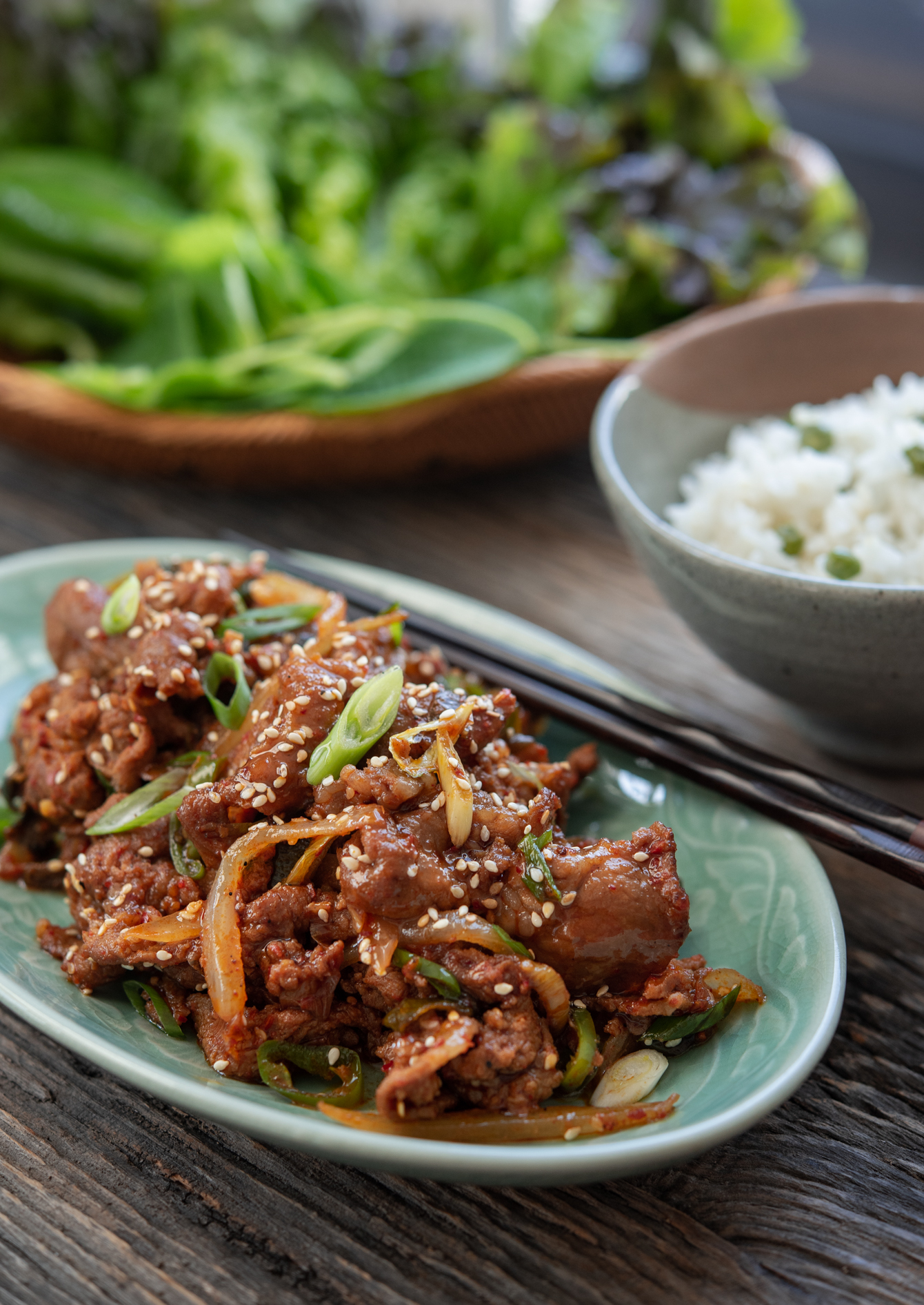
“This was so easy, and turned out WONDERFUL. Both boyfriend and I loved it. Thank you so much for this recipe! It’s a keeper!”
mandalameg
The spicy pork dish from Korea is known by names like Jeyuk Bokkeum (제육볶음) and Dweji Bulgogi (돼지불고기), which means pork bulgogi. “Jeyuk” stands for pork and “bokkeum” means stir-fry. It’s a spicy pork stir-fry using a sweet and spicy sauce called gochujang.
This dish is a favorite at Korean BBQs and loved all over the world. It’s simple to make with just a few basic Korean ingredients. Follow my recipe and cooking tips, and you’ll be able to make spicy pork bulgogi that tastes even better than what you get in restaurants.
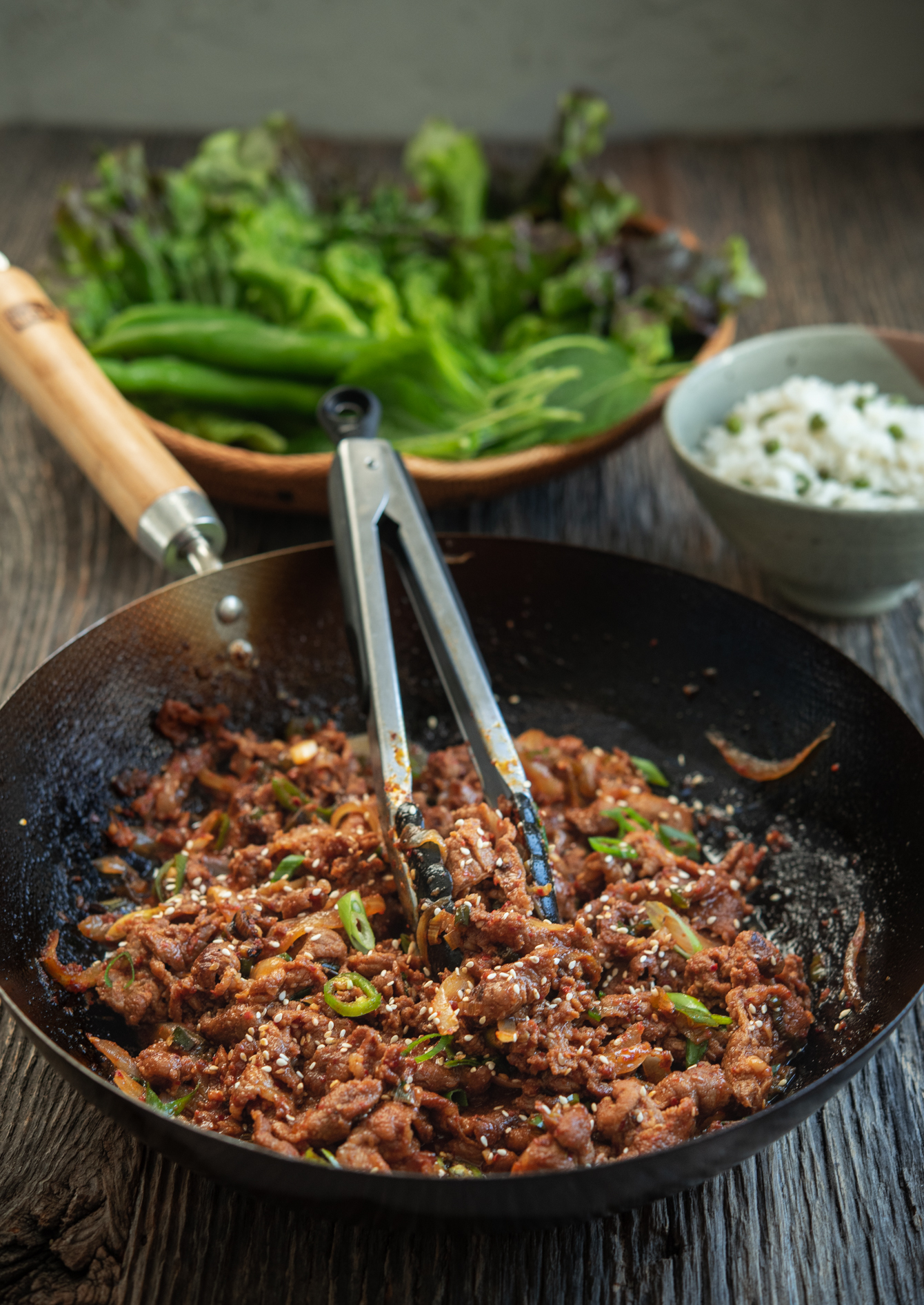
How to make Spicy Pork Bulgogi (Jeyuk Bokkeum)
The Pork
For this recipe, you need pork with some fat, or “marbling,” to keep the meat moist and tender. Pork shoulder (or pork butt) is ideal because it has the right amount of fat. Make sure the pork is thinly sliced. While some people use pork belly, I find it too fatty for stir-frying.
You can buy pre-sliced thin pork shoulder (moksal) at Korean stores, available both fresh and frozen. If you prefer to slice the meat yourself, freeze it for about an hour first to make cutting easier. To ensure the pork absorbs the sauce evenly, make sure to thinly slice it.
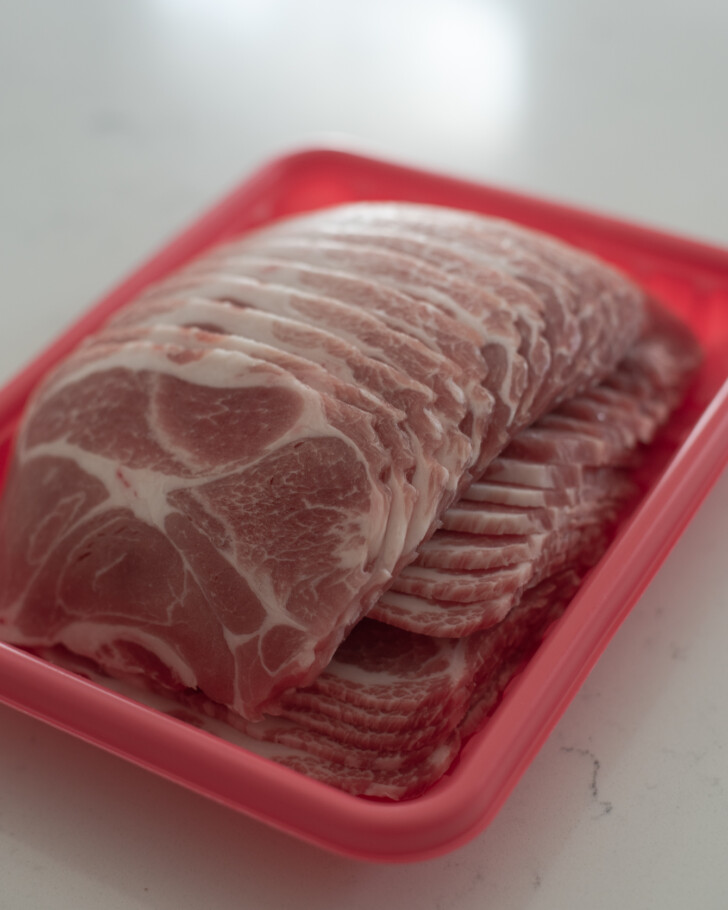
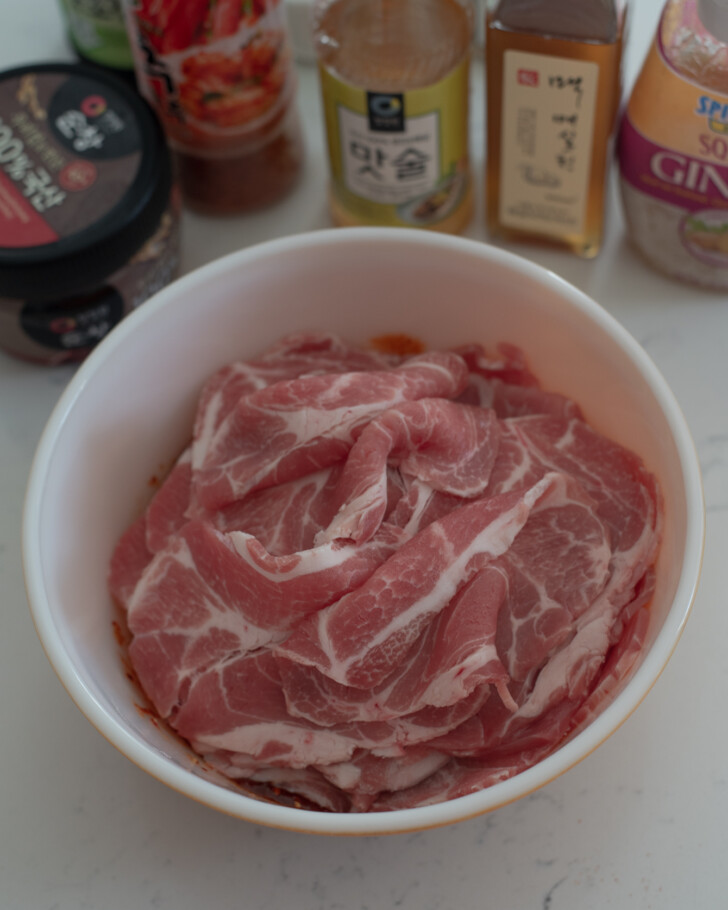
Mixing the Spicy Marinade
In this dish, unlike beef bulgogi which mainly uses soy sauce in its marinade, the key ingredient is gochujang. This spicy yet slightly sweet Korean chili paste pairs well with fatty pork, enhancing the flavor.
You can adjust the heat level by changing the amount of gochugaru (Korean chili flakes) you use. If you’re not a fan of spicy food, you can skip the chili flakes altogether.
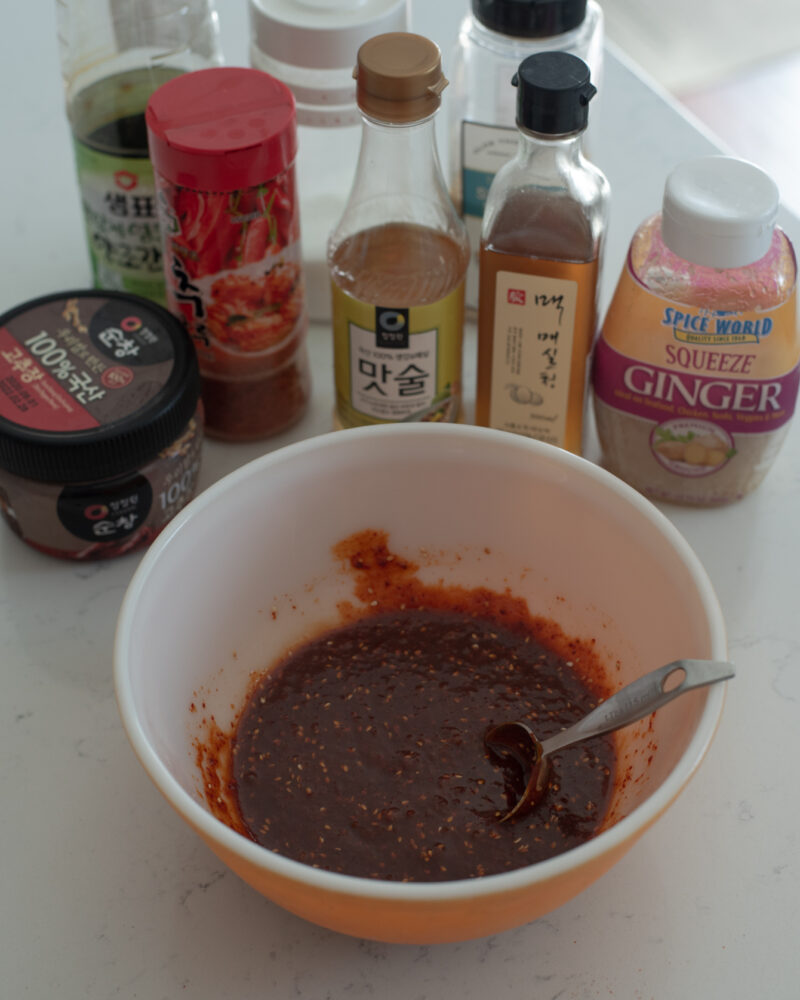
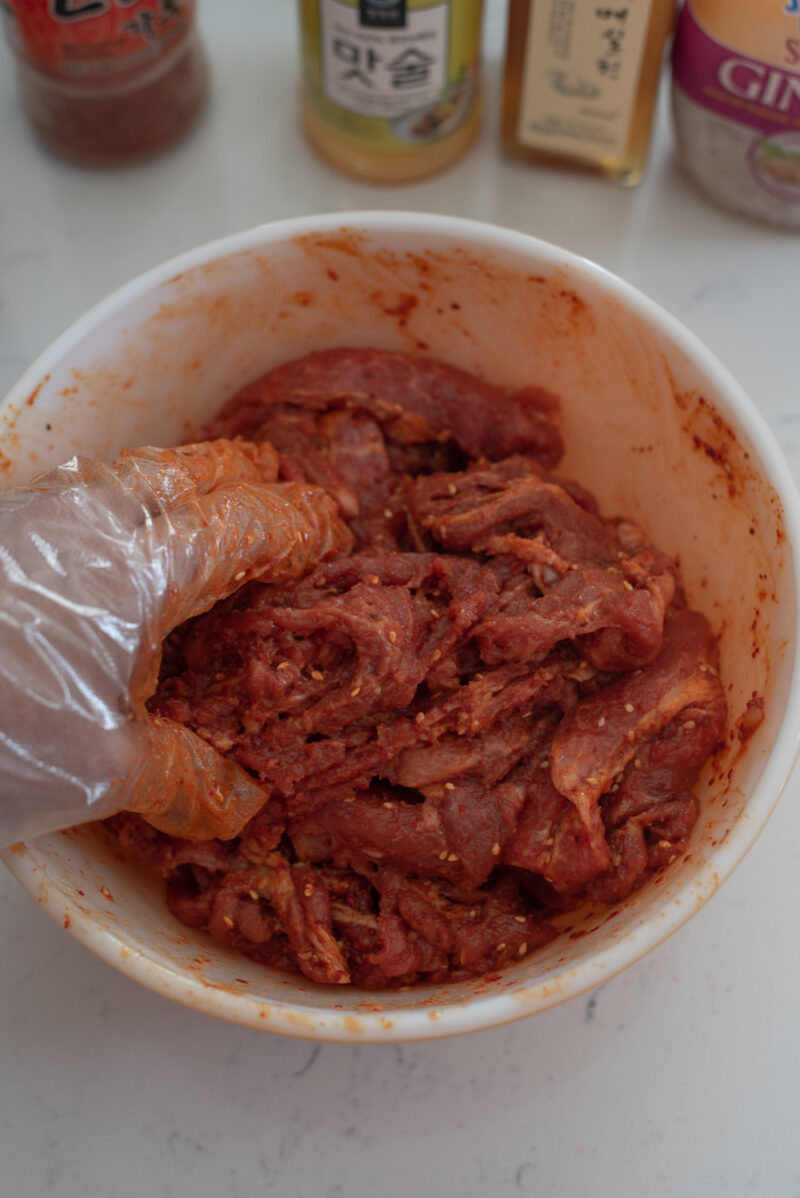
Fresh garlic and ginger are crucial to this recipe! They help reduce the porky smell and elevate the flavors of the dish. Combine all the sauce ingredients in a large bowl, add the meat, and mix everything together.
If you want to try this spicy pork bulgogi sauce with a slightly different version, try my chicken bulgogi recipe. It’s equally tasty and everyone who tried that recipe have raved about it.
The Stir-Frying Process
Marinated pork can be grilled over an open fire or pan-fried. In Korean homes, it’s typically pan-fried, which is why it’s called jeyuk bokkeum, meaning stir-fried pork.
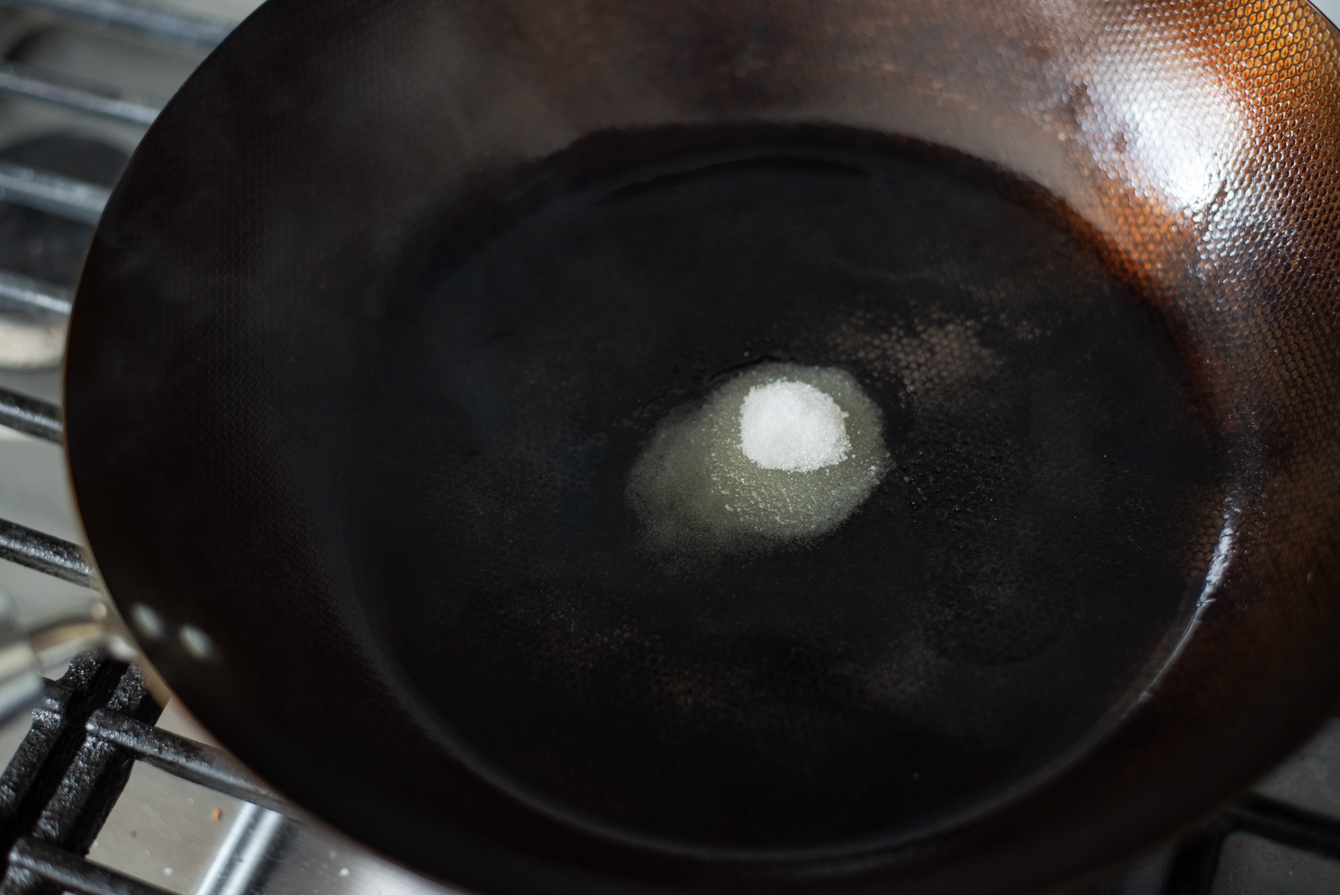
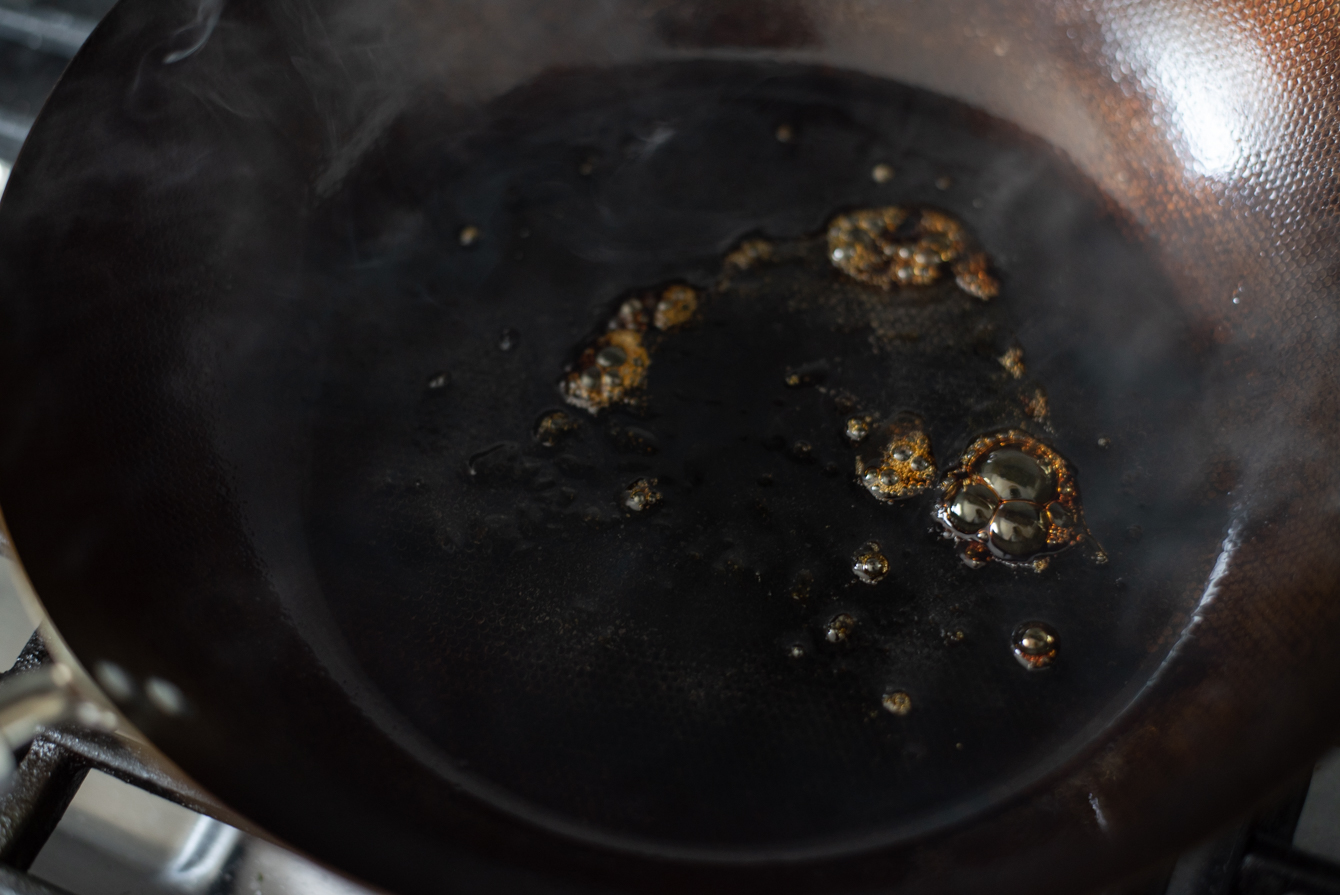
Caramelize the sugar. Heat 2 tablespoon of oil in a deep skillet or wok over high heat. Add 2 teaspoon of sugar and swirl the pan around. Let the sugar turn brown and caramelized.
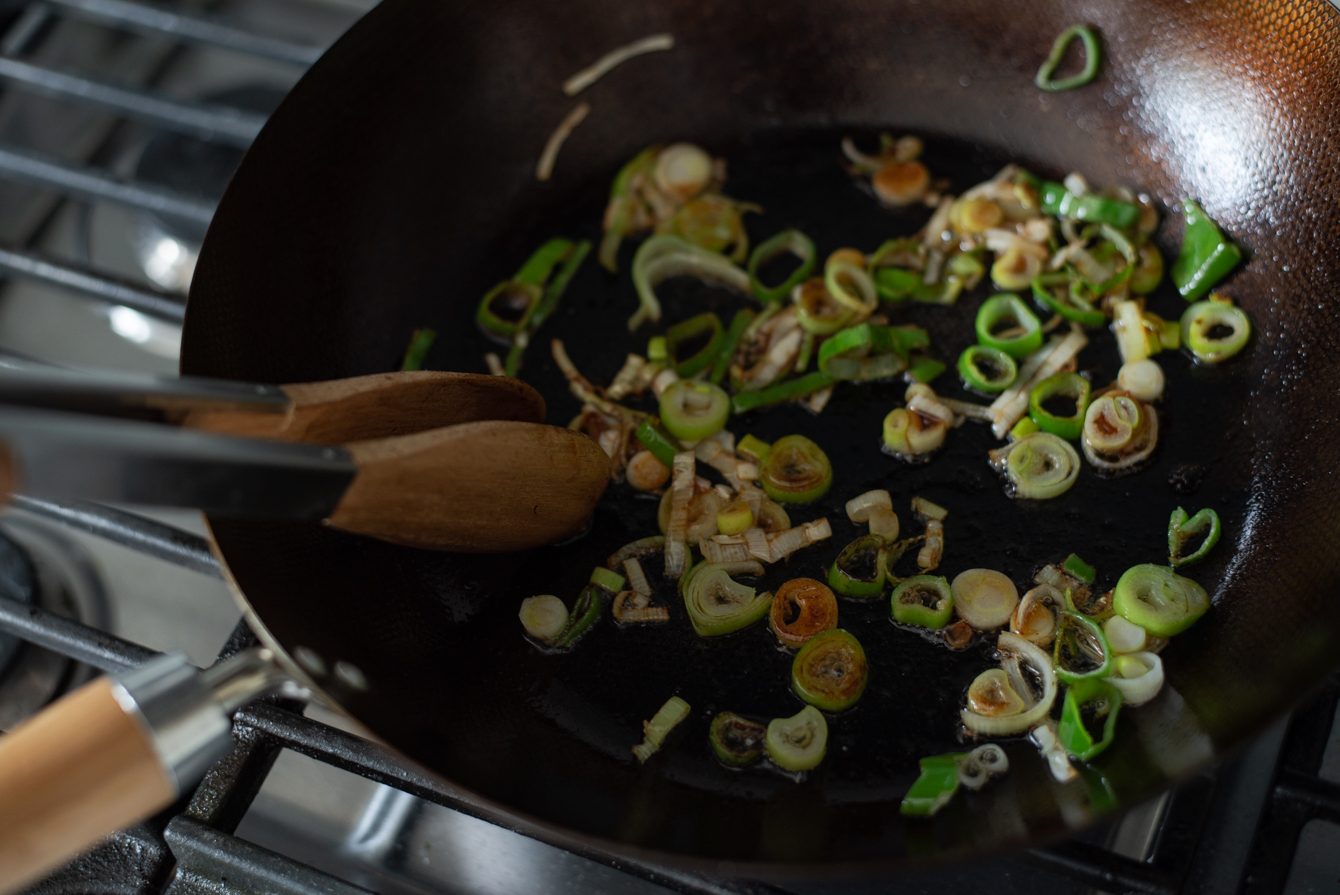
Infuse the leek (or green onion). Quickly add the chopped Asian leek (or green onion) and stir-fry for 30 seconds to infuse the oil.
Note: Infusing the leeks in caramelized sugar adds a smoky taste to the meat, which enhances the overall flavor of the dish.
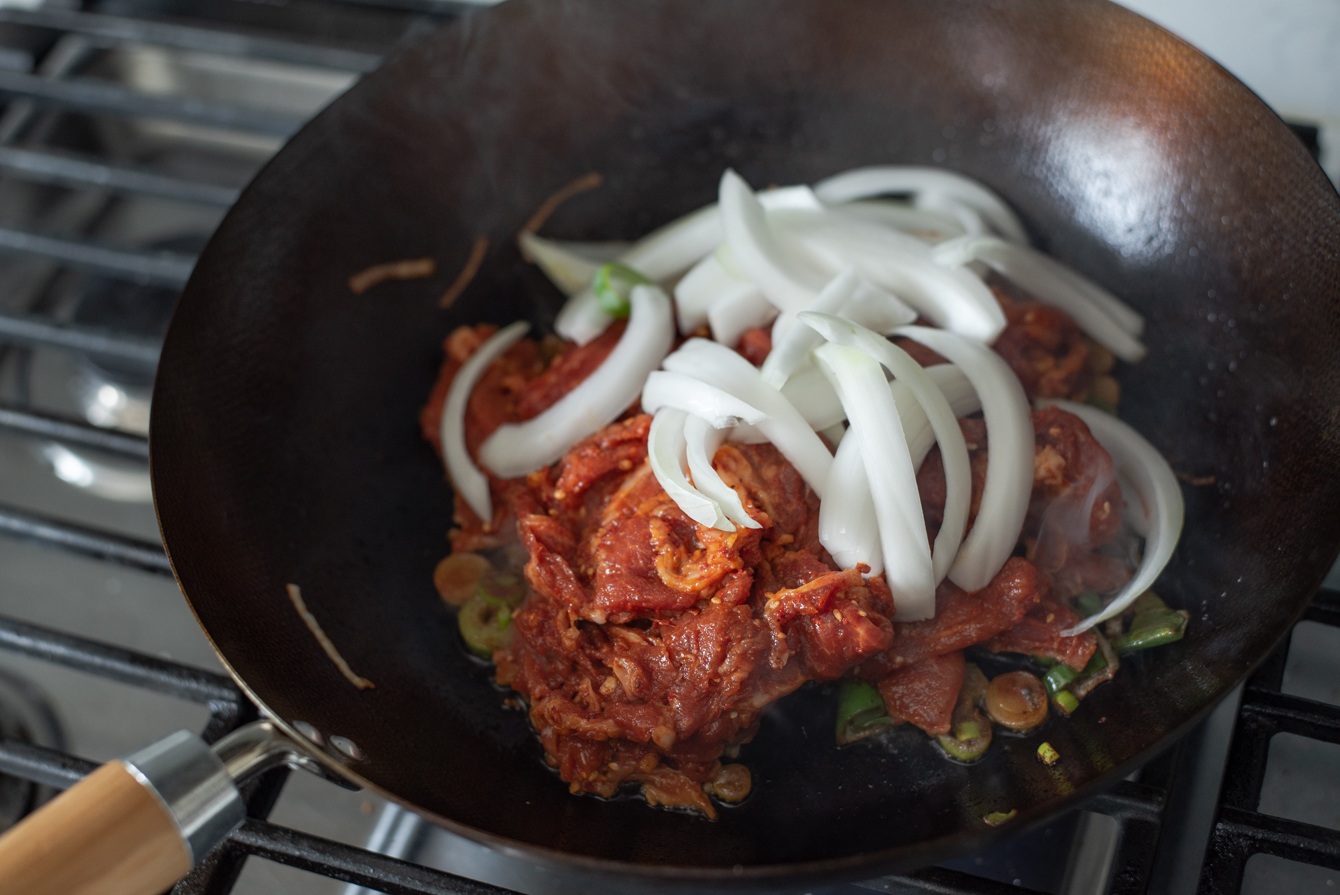
Add the marinated pork and onion. Add pork and onion while keeping the heat high. The meat should sizzle right away when you add it to the skillet.
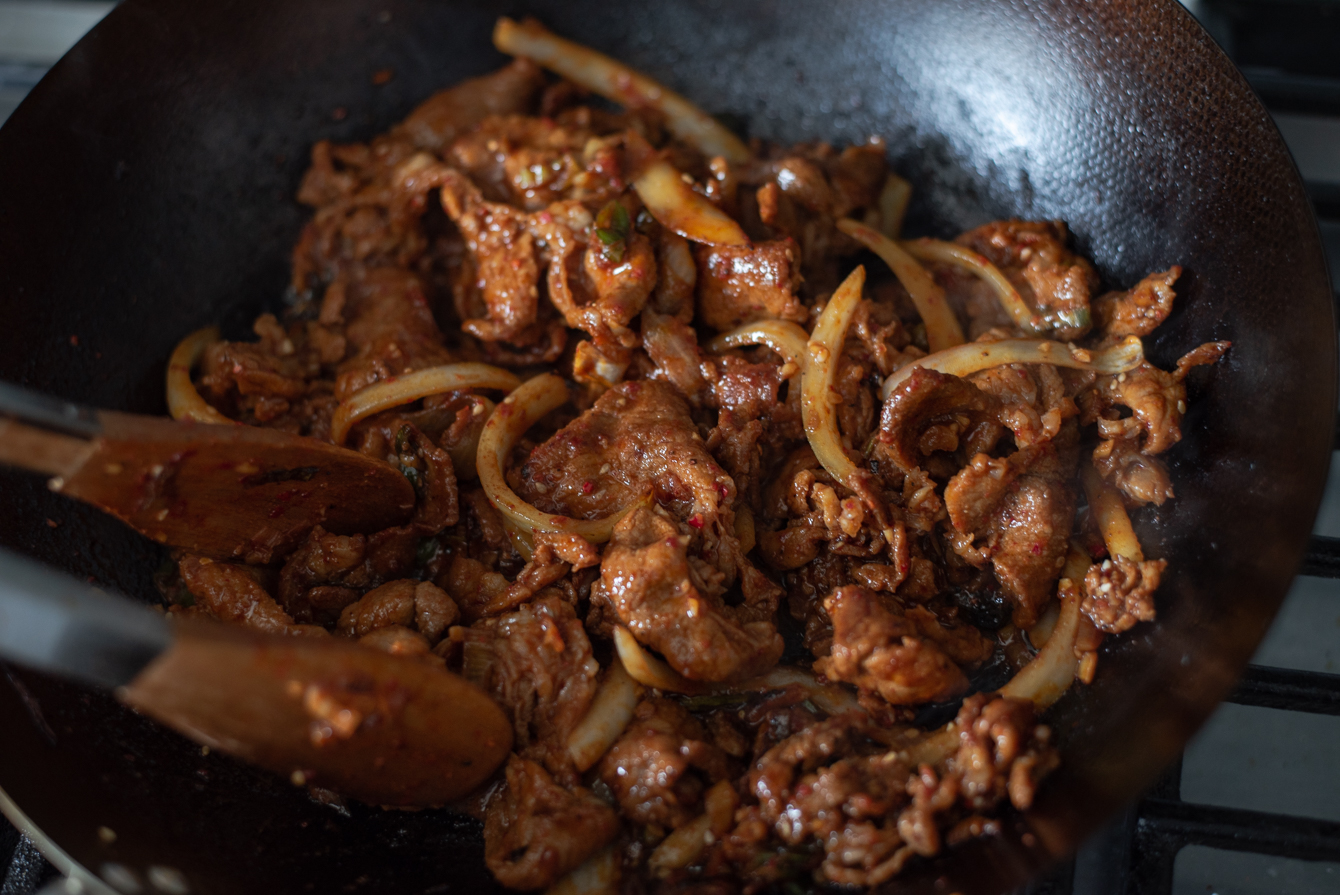
Stir-fry the pork. Stir-fry pork and onion until they are fully cooked and tender. Serve immediately with rice.
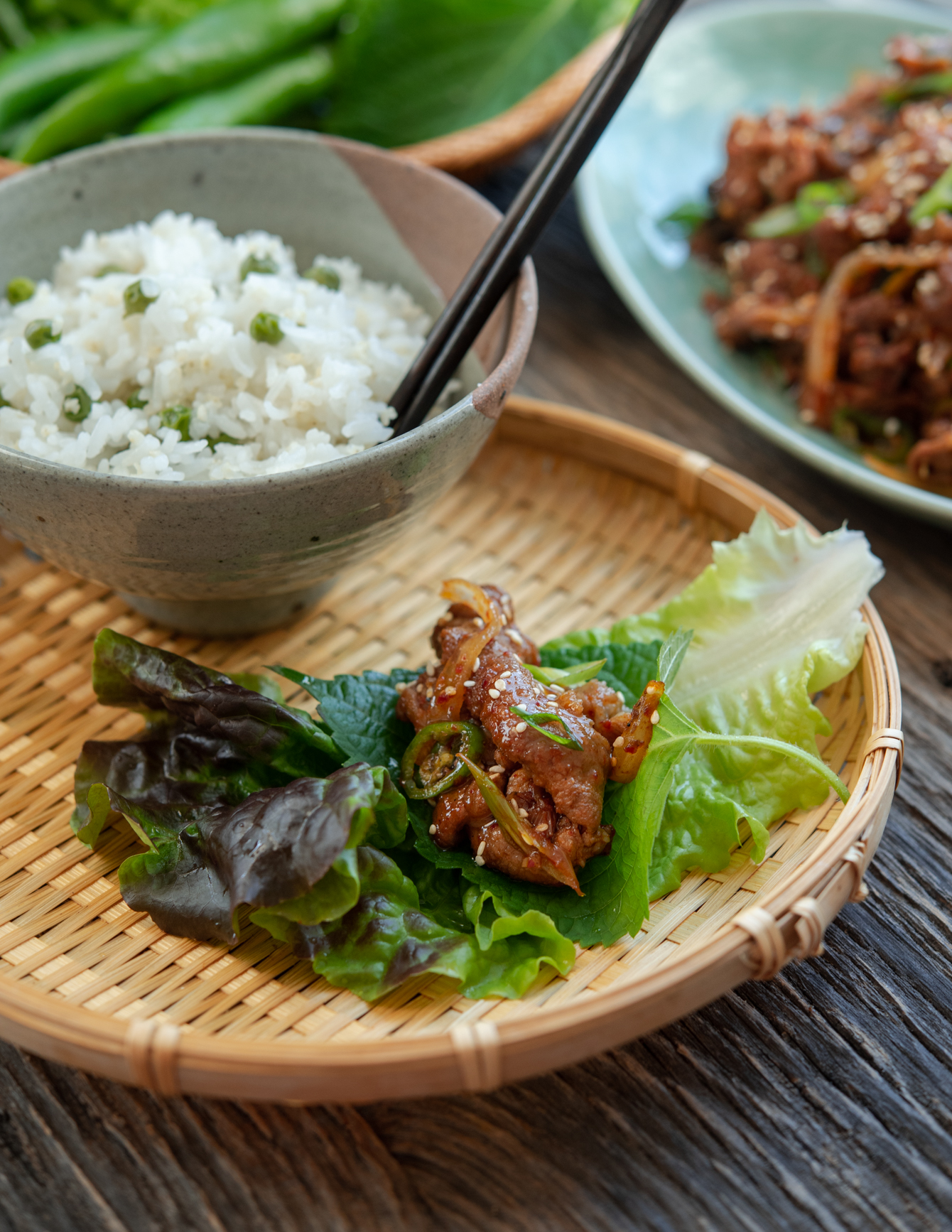
Serving Spicy Pork BBQ
You can enjoy this dish with just a bowl of rice and some Korean side dishes. However, it tastes even better wrapped in leafy greens like red or green leaf lettuce and perilla leaves (kkaennip), topped with ssamjang, similar to how you would enjoy Korean BBQ.
While many Korean households pair jeyuk bokkeum with doenjnag jjigae (Korean soybean paste stew), it’s not mandatory. The choice is yours!
What Sets This Recipe Apart
This recipe stands out because of how it’s cooked. Quick stir-frying leeks with caramelized sugar before adding the pork infuses a smoky flavor that greatly enhances the taste of the dish. Give it a try, and you’ll find yourself making it over and over again.
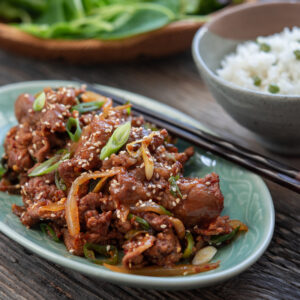
Spicy Pork Bulgogi (Jeyuk Bokkeum)
Ingredients
- 2 lb (900 g) pork shoulder , or pork butt, very thinly sliced
- 2 tbsp canola oil
- 2 tsp sugar
- 1 Asian leek , or 4 green onion, chopped
- 1/2 large onion, sliced
For seasoning paste:
- 6 tbsp Korean chili paste (gochujang)
- 1-2 tbsp Korean chili flakes (gochugaru)
- 2 tbsp soy sauce
- 2 tbsp sweet rice wine (mirim)
- 2 tbsp sugar
- 3 cloves garlic, finely minced
- 1 1/2 tsp ginger paste
- 1 tbsp sesame oil
- 1 tbsp toasted sesame seeds
- 1/2 tsp black pepper
Instructions
- To make the seasoning paste for pork, combine chili paste, chili flakes, soy sauce, rice wine, sugar, garlic, ginger puree, sesame oil, sesame seeds, and black pepper in a small mixing bowl; mix well.
- In a large mixing bowl, separate each slice of pork and put them in a bowl. Add the seasoning paste and mix well (Wearing a disposable food glove is helpful). You can make this step ahead of time and let it marinate in the refrigerator up to 24 hrs. Or you can go straight to stir-fry without marinating at all.
- Heat 2 tablespoon of oil in a deep skillet or wok over high heat. Add 2 teaspoon of sugar and swirl the pan around. Let the sugar turn brown and caramelized.
- Quickly add the chopped Asian leek (or green onion) and stir-fry for 30 seconds to infuse the oil. Add pork and onion. Stir-fry pork and onion until they are fully cooked and tender, about 3-4 minutes. Serve immediately with rice and lettuce (if desired).
- Note: If your skillet is not big enough to stir-fry the entire batch of pork, divide the pork in half or in portion you desire. If so, you will need to reduce the amount of oil, sugar, and leek to caramelize per batch accordingly.


Absolutely delicious! This will definitely be a part of our meals from now on. It was spicy but not burn your mouth hot. The flavor was so good! The only addition was some cubed zucchini that was added because I needed to use it up.
Can I use ground pork for this recipe? Thanks!
Hi Lzzy
Ground pork will work with the recipe. Hope you like it. Thanks.
This was amazing! My first time cooking Korean food and it turned out so good I could eat it everyday. Regards from Sweden!
Hi, can’t wait to try this recipe this week. I made the chicken bulgogi last week and it was amazing!! I have a bit of a silly question though: Do you stirfry the slices of pork as they are or do you cut them into strips before?
If you bought the Korean style thin pork slices, you can use it the way it is or cut in half to make it smaller before you add the seasoning. Hope you like this pork bulgogi. It is delicious!
Made this recipe tonight. It is delicious, will definitely be making this often. Thank you for the recipe 😊
Hi Jean
So happy to hear that you liked it. Thanks for the comment. I appreciate it.
This pork looks so flavourful! Can’t wait to make it soon!
I made this. I was born in Seoul. However I HATE wasting leftovers! So if you will, laugh!
I used the dreaded honey baked ham as the meat. I omitted the sugar! It wasn’t authentic, but it was okay with a kick lol!
Nevermind. I had a second helping and although palatable the allspice and cinnamon powers through……ick! lol
Making this for a mother that does not like spicy food and a five year old brother, wish me luck on controlling the heat! I’ll likely leave out the pepper flakes.
You can leave the chili flakes out. Hope they like it.
Delicious, the 24 marinade is mandatory. Very tasty and not really all that spicy.
This is absolutely EASY and so TASTY. I struggle with some Korean dishes, as I usually mess something up and SOME TASTE is missing that I can’t point my finger at.
This was so easy, and turned out WONDERFUL. Both boyfriend and I loved it.
I used pork tenderloin thinly slice (as I had it on hand) – and while it took a bit longer to cook it was still perfect.
Thank you so much for this recipe! It’s a keeper!
That’s wonderful to hear! Glad that you liked this recipe. It is indeed simple to make and so delicious! Thanks for the comment!
Thanks so much for the recipe, I am very excited to try it! Just one question, when you say “Korean chili flakes,” is that the same as crushed red pepper flakes: http://www.savoryspiceshop.com/content/mercury_modules/cart/items/2/7/3/2739/chile-crushed-red-pepper-flakes-1.jpg? If not, can you provide me with a photo of the jar/container your chili flakes come in? I couldn’t find “Korean chili flakes” in the store tonight. Thanks again!
I think I’ve answered my own question: http://files.blazinghotwok.com/labels/vegan.html. I guess I should have Googled first *roll-eyes.*
Hi there! I just discovered this recipe through pinterest last week and I’ve already made it twice! My boyfriend and I love it! It was so quick and easy and tasty.
I followed your recipe this Sunday and served this to my friends at church. It was a big hit! Though, I had to substitute corn syrup with honey so it could have been sweeter than yours.
One thing I would like to mention is that H-Mart actually carries paper-thin cut pork for shabu shabu, but I don’t think that’s ideal for this dish. I found slightly thicker cuts of pork shoulder next to it, so luckily it turned out perfect!
Thanks for sharing these awesome authentic recipes!
Will it change the taste/texture to let it marinate overnight before cooking? Or do you recommend adding the sauce right before cooking?
Of course you can marinate overnight. It will intensify the flavor. Let it stand at least 15 minutes before you cook.
We go to a predominantly Korean church here in Arkansas and we cook every Sunday. As much as I love my Eldresses I know some of them don’t give the “secrets” to their dishes lol I have down the bulgogi and cucumber kimchi but until now couldn’t get a good flavor on my pork! Oh my this was perfect. I love this website!
Looks delicious!
맛있네 !!! like most of Korean dishes … greta pics and directions …
I made this and it was amazing. Thank you for the recipe Holly.
That’s great Atuk! Thanks.
Hi Holly, just wanted to let you know, that I’m a new, but avid reader of your entertaining blog. After some difficulties obtaining the ingredients (I hail from Germany) I cooked your Spicy Pork today. It was just wonderful! My son (13 yrs. and extremely choosey) loved it too! There are no left-overs, so the rest of the family will have to wait to taste it. 😀
Thank you!
I’m determined to make my spicy pork better. I’ve tried three different recipes, and your proportions seem best to me. I might omit the red pepper flakes as I find the gochujang quite spicy as is. I haven’t come across a recipe with corn syrup. I see it’s optional, but what exactly does it add to the dish that the regular sugar doesn’t? I’m curious. Thank you for a great site!
Hi Jerry, you can omit the corn syrup. Corn syrup gives a nice sheen to the dish. I highly suggest to add Korean chili flakes, though. It adds a nice spicy chili kick that gochujang alone doesn’t give. You can use only half the amount if the spiciness is a concern. Let me know if you need further assistance.
Beautiful, holly. I can just imagine having a mouthful of rice and this pork together. Yummm….
I finally cooked this last week and it was so so good! So much so that hubby was raving about it for days afterwards. So, I’m giving you love back for this.
And the pork neck meat is the right cut for this, just the right amount of fat. I couldn’t find the thinly sliced pork in my local butcher, instead I got a slab of pork neck meat and sliced them myself, I might have to do a post about this, hopefully sooner than later.
That is great to hear. Would love to see the post how you make the dish.
I just made this again today with a small handful of oyster mushrooms. And it’s as tasty and addictive as I remember it!!
Awesome! Mshrooms are great addition to this dish. Yeah, this spicy pork is quite addictive once you try it. Thanks!
Korean Pork is a great dish and easy to make. One of my favorites!!!
Big bowl of rice please! This is wonderful… I love pork dish and although I cannot eat very spicy food, I will control the level of spiciness. My mouth water by looking at your beautiful pictures. Whenever I come to your site, it makes me think I need to have good light and good photography skills to convince everyone it’s good food. You’re always doing amazing job!
You are so sweet Nami. Thanks for the compliment. I think having the natural light is the best tool for good photography and I still need to understand how to use light more properly. What type of lighting do you use in your pictures?
I also feel like I’m the only Korean/Asian who does not do well with Math. All through school and even college, I received A’s in every subject except Math and Science! :-(. Food looks delicious! I will have to try the recipe.
Some of my favorite ingredients are listed here! I love how easy and flavorful this is.
Oooooooh wow wow wow! This looks beautiful, and I will definitely be making this. How lovely. We don’t have an Asian market in our town, and I don’t want to wait until my next trip (our nearest Asian supermarket is approx 25 miles away) so I will be attempting to thinly slice the meat myself. I’ll semi-freeze it first so I can get it lovely and thin like that.
Delicious, Holly, as always – thank you for posting.
Semi freezing is great way to cut meat thinly. Let me know how you like the dish, Vicky. Thanks!
Mmmm… Jeyuk bokkum is one my favorites! I sucked at math too! Or so I thought… until I came to America and took stats in college and absolutely loved it and got my first A in MATH!! Anyway… I am now craving some of this… Yum!!
I am drooling just over your photos — I can practically smell this in the pan and feel the scent clinging to my hair. Thanks for a gorgeous recipe!
Easy-peasy indeed! And looks darn tasty. I actually enjoyed 7th grade algebra. But the more advanced math? Let’s not talk about that. 😉 Very nice recipe – thank you.
Yup, I know what you mean.